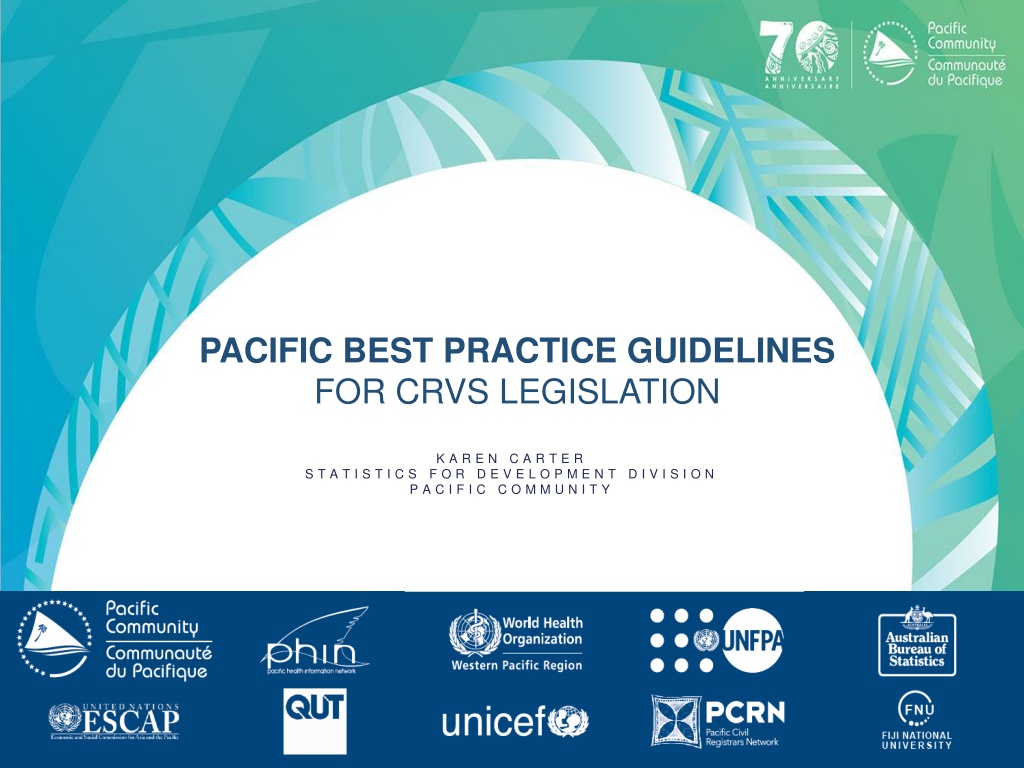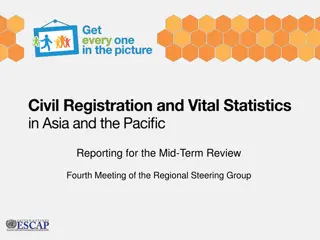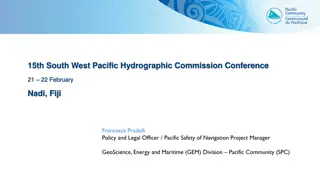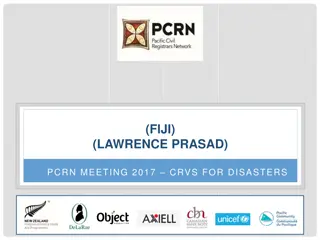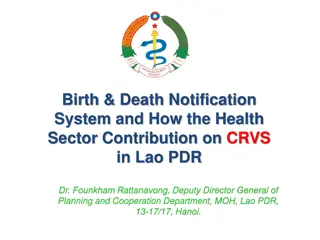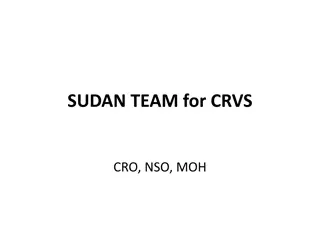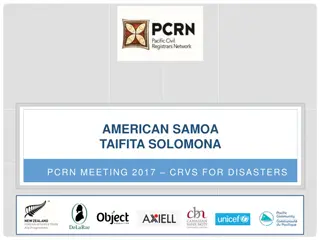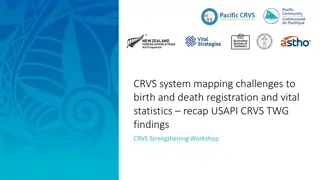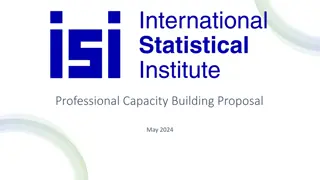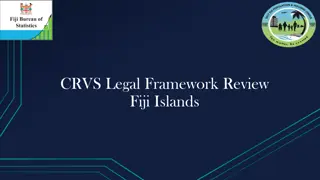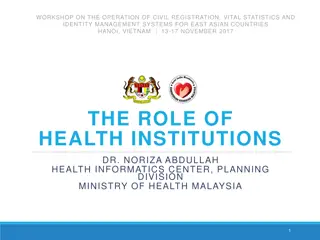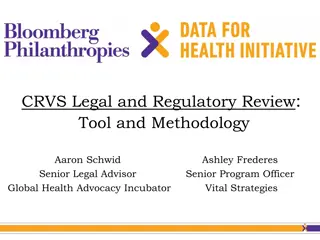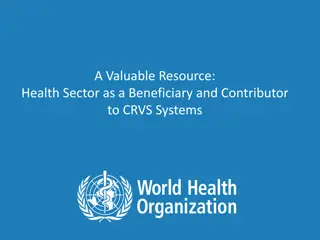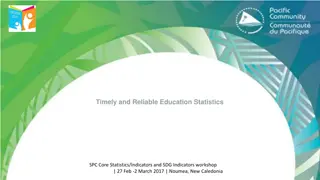Pacific Best Practice Guidelines for CRVS Legislation and Recent Developments
Core priority for the Pacific region is updating outdated legislation for Civil Registration and Vital Statistics (CRVS) systems. Many Pacific countries are revising their laws with support from partners to comply with modern standards, like the Asia-Pacific CRVS Decade. Major acts and regulations across various Pacific nations reflect the evolution of CRVS legislation over time.
Uploaded on Sep 23, 2024 | 0 Views
Download Presentation

Please find below an Image/Link to download the presentation.
The content on the website is provided AS IS for your information and personal use only. It may not be sold, licensed, or shared on other websites without obtaining consent from the author. Download presentation by click this link. If you encounter any issues during the download, it is possible that the publisher has removed the file from their server.
E N D
Presentation Transcript
PACIFIC BEST PRACTICE GUIDELINES FOR CRVS LEGISLATION K A R E N C A R T E R S T A T I S T I C S F O R D E V E L O P M E N T D I V I S I O N P A C I F I C C O M M U N I T Y
A CORE PRIORITY FOR THE PACIFIC.. Identified in many national assessments as a key priority for action. Much of the current legislation in the region is out of date (Oldest Nauru 1957) The Pacific has made some important legal commitments around CRVS especially through the Asia-Pacific CRVS Decade and RAF Multiple countries currently undertaking legal revisions with BAG partner support: Vanuatu, Tonga, Solomon Islands
Year of most recent legislation Country Major Acts/ Mechanisms/ Regulations (year enacted) Births, Deaths and Marriages Ordinance (1957) Civil Registration Act (1963) Nauru Papua New Guinea Tokelau FSM 1957 1963 Births and Deaths Regulations (1969) Code of the Federated States of Micronesia (Chapter 1 Health services administration) (1982) Births and Deaths Registration Regulations (1984) Births, Deaths and Marriages Registration Act (1988) Births and Deaths (Registration) Act (1996) Births, Marriages and Deaths Registration Act (1996) Chapter 2: Vital Statistics (1992) Births and Deaths Registration Ordinance (1920) Historical only Births, Deaths and Marriages Registration Act (2002) American Samoa Statistical Act (2003) Vital Statistics Act of 2006 Civil Status (time for making declaration) (1975) Civil Status (Registration) Act (1988) Burials Act (1988) Civil Status (Registration) Act (2006) Civil Status (Registration) Act 2014 (in development) Births and Deaths Registration Act (1973) Births and Deaths Registrations (Fees) Regulations (1998) Births and Deaths (Amendment) Act (2007) Births, Deaths and Marriages Registration Ordinance (1968) Births, Deaths and Marriages Registration (Amendment) Act (2007) Births, Deaths and Marriages Registration Act (2008) Court Order In the Matter of Birth Certificates (22 Sept 2011) Section 34 Palau National Constitution (1979) Births, Deaths and Marriages Registration Act (1988) Births, Deaths and marriages (and missing persons amendment) Act (2007) Births, Deaths and Marriages Registration Act (2012) 1969 1982 Niue Tonga Solomon Islands 1984 1988 1996 Guam Samoa 1997 2002 American Samoa 2003 CNMI Vanuatu 2006 2006 Cook Islands 2007 Kiribati 2007 Tuvalu Palau 2008 (2011)* 1979 2012 RMI Fiji Islands 2014 Births, Deaths and Marriages Registration Act (1975) Births, Deaths and Marriages Registration (Amendment)Act (2014)
KEY PROBLEMS Clarity of roles and responsibilities Ambiguity of reporting requirements for births and deaths Enforcement/Application of legislation Contradictory or outdated legislation Data protection Costs and finance provisions Late registration doctors have expressed concern regarding the procedural expectation for them to act outside of the law in issuing certificates for deaths that occurred in the past registration of births to single mothers without the father having to be named Fees may legally only be able to be collected by another ministry or may not allow electronic processes, Social issues managing adoptions both within families, and to prevent inappropriate overseas adoptions. responsibility (and associated procedures) for health professionals to forward deaths potentially due to assault or injury for further investigation, Infrastructure and resourcing are not covered in the act Delegation and System design
EMERGING NEEDS Emerging technology and the movement of people across the region have also highlighted new opportunities and needs. allowing for the use of electronic registers in place of paper forms, the potential use of mobile technology to improve registration coverage, provisions to share data across borders to the place of initial registration in order to close a registration or identity when someone dies, and protection of data while facilitating legitimate uses either within government (such as for electoral rolls) or external to the government system (such as for duly approved health research). National ID systems and e-government processes to improve data sharing, planning and governance and improved accessibility to registration; civil registration is critical for assigning legal identity (and closing these records as a person dies) as the foundation for both of these broader functions to be successful.
BEST PRACTICE NOT MODEL LEGISLATION Draws from a broad range of existing principles and standards; as well as direct partner experience and country feedback Reviewed by all PICTs Recognition of the differences in administrative structures and historical legal frameworks across the region and the subsequent difficulties in developing a relevant model format. Request from PICTs for a more modifiable approach. Similarly, while many provisions will fall under a central CRVS act of some kind, others may be adequately covered under various other acts or mechanisms. 2 main sections: Principles for CRVS legislation Core elements and examples
PRINCIPLES Be Inclusive Encourage the sustainability of the registry office as a core government function through appropriate resourcing. Be Accountable Provide the basis for legal identity Be consistent with other acts and mechanisms Be compulsory Protect registry and associated staff Prevent discrimination Encourage the formalised collection of cause of death data Support registration as a free service Require that vital statistics are regularly produced, verified and made publically available. Protect the interests of individuals Clearly outline roles and responsibilities, procedure, and penalties. Support simplicity including through: Encourage good record management and protection. The use of plain, easy to understand language Support for one national structure, rather than multiple parallel systems. Protect the official status of the data Support data sharing for legitimate use by the government and other relevant players Be sufficiently flexible and responsive to support overall system improvement and allow for improvements in procedures and technology. Support data sharing with international registry partners within the region Allow for regular revision and updates
CORE COMPONENTS 1. 2. 3. 4. 5. 6. 7. 8. Purpose and functions Scope population Scope events Registers Certificates/ legal documents Roles and functions of key stakeholders Delegation and authority Compulsory nature of registration a) Responsibilities for reporting b) Timeframes for reporting Evidence for registration 10. Registration processes a) Births b) Legitimisations c) Adoptions d) Name changes e) Deaths 11. Burial 12. Late registration provisions 13. Causes of death a) Medical Certification b) Framework for Verbal Autopsy 14. Unnatural deaths 15. Corrections and amendments 16. Data protection 17. Data sharing and access a) Legitimate use of data b) Research applications c) Off-island events d) Public enquiries e) Closed records 18. Statistical Use 19. Fees and penalties a) Payments for registry functions b) Penalties c) Interference with registry functions/ staff 20. Complaints and review 21. Infrastructure and resourcing 22. General legal provisions a) General set-up b) Relationship with Other acts c) Definitions d) Ability to formulate and enact regulation/ policy e) Transitory and derogatory provisions (incl. dates) 9.
PROCESS Initial assessment should be based on comprehensive assessment (based on WHO framework), stakeholder consultation and system process mapping Determine if legal review is the national priority CRVS committee to consult with key stakeholders Determine if a revision or new legislation is required Ensure that key issues have been identified Deal with structural decisions before starting on drafting LEGISLATION SHOULD SUPPORT GOOD SYSTEM DESIGN IT SHOULD NOT DRIVE DECISIONS ABOUT THE OVERALL STRUCTURE OF THE SYSTEM Best practice guidelines provide both a lens for evaluating proposed changes to address issues identified and provides examples as a checklist of key elements to consider including.
